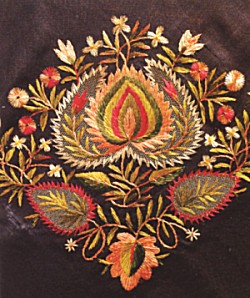
Detail of shawl, Alsace, beginning 19th c., called 'Freid und Leid' (joy and grief)
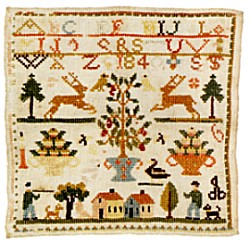
Sampler, Alsace
1840,
canvas, cotton, wool threads, crossstitch
| ANNE WANNER'S Textiles in History / exhibitions |
| at
the back of the Cathedral Galerie Heitz of Palais Rohan |
tel:
++ 03 88 52 50 00 www.musees-strasbourg.org Ateliers de broderie |
opening
hours: every day from 10 am to 6 pm closed tuesdays guided tours: |
Broder sans compter 26 Novembre 2004 until 7 March 2005 catalogue at: http://www.musee-strasbourg.org/F/EDITIONS/EDIT_NOUVEAUTES.HTML#cat_broderie |
|
| Conférences:
de Nathalie
Bresson, journaliste, maître socioloogie Atelier de broderie:
- du 3 janvier au 6 mars: "Autour
des abécédaires", initiation à la
broderie pour les enfants de 7 à 12 ans, accompagnés
d'un adulte: - "Broderie
traditionnelle: l'essuie-mains d'apparat, le plastron, le
bonnet de de coiffe" |
Detail of shawl, Alsace, beginning 19th c., called 'Freid und Leid' (joy and grief) |
Sampler, Alsace
1840, |
Embroidery to
hide towels, Alsace around 1900, |
|
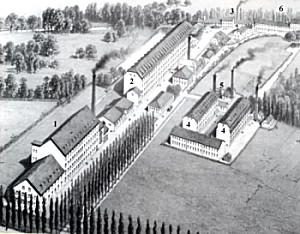 |
In the catalogue one of the chapters describes the development of the factory DMC in Mulhouse. This is also the history of the embroidery yarn DMC and of the family Dollfus-Mieg. This was also the place where Thérèse
de Dillmont had her embroidery atelier. Here she
created her pattern books on embroidery. |
|
| Last but not least
the exhibition also shows a linen embroidery. It points to the fact, that the rhine region has a very old tradition in embroidery. |
|
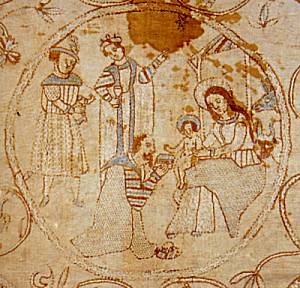 |
Three
scenes from a linen emboidery, 1615, MAD below: |
|
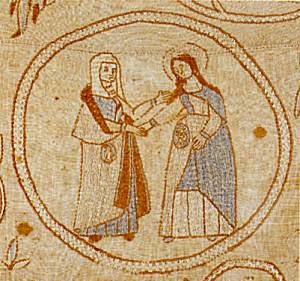 |
|
The Rohan Palace: The Alsatian museum: |
| Press
release: Embroidery enjoyed a revival some ten years ago and ever-increasing numbers of women enthusiasts are re-discovering its attractions. Alsatian cross-stitch embroidery with its use of the “Rouge du Rhin” thread is of course well-known by now, but the exhibition also offers an opportunity of discovering many other of its features with a display of some 200 pieces from the collections of the Strasbourg Museums that are seldom on public view. They bring out the region’s particular place as a crossroads where popular traditions of central Europe and the influence of Paris fashion converge. Taught at school as calligraphy, the art of embroidery serves to mark linen and to adorn cloths associated with Jewish or Catholic rites of passage. A sartorial embellishment, embroidery is prominent on 18th-century silk waistcoats, on shawls and peasant women’s bonnets. “Needle-painted” pictures or ceremonial hand towels contribute to interior decoration in town and country. |
| how to order the
catalogue: |
|
| Régie des Musées 5, place du Château BP n°1049/1050F 67 070 Strasbourg cedex Guy Fritsch tél. ++ 03 88 52 50 35 fax. 03 88 52 50 09 Claude Pierret-Meyer tél. ++ 03 88 52 50 00, poste 35026 fax. 03 88 50 52 09 Envoyer par fax ou courrier votre demande d’exemplaires à l’attention de Guy Fritsch, responsable financier, qui fera suivre votre demande. Une remise de 30 % sur le PPHT est consentie aux libraires par arrêté municipal. Une participation aux frais d’envoi forfaitaire d’environ 3 euros sera demandée. L’envoi des exemplaires s’effectuera (en courrier normal) à réception du bon de commande ou de votre demande écrite. Le paiement devra s’effectuer à réception de l’avis d’encaissement du Trésor Public (par chèque ou virement bancaire). Pour de plus amples renseignements sur un dépôt, la distribution et le paiement : Régie des Musées, Mme Claude Pierret-Meyer |
| home content | Last revised 22 January 2005 | For further information contact Anne Wanner wanner@datacomm.ch |